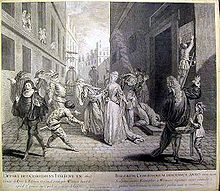Théâtre Italy

The Théâtre-Italien or the Comédie-Italienne was a Parisian theater and opera institution of the 18th and 19th centuries that played in different houses.
history
The first operas to be played in Paris (since the middle of the 17th century) were works in Italian, but Italian opera lost its importance in favor of French opera , especially since the Académie Royale de Musique was founded. Despite this, Italian singers came to Paris during the 18th century. In 1752, on the occasion of the performance of Pergolesi's opera buffa La serva padrona, the Buffonist dispute broke out, a dispute over the primacy within French and Italian musical traditions.
In 1787, after the particular success of a troupe of Italian singers, the idea of setting up a standing theater group for the “Opera buffa” in Paris came up. This initiative was implemented in January 1789 with the establishment of the Théâtre de Monsieur , a company that soon came under the patronage of the Count of Provence (later: Louis XVIII. ), The king's brother. There were first performances in the Theater des Palais des Tuileries , even before the Théâtre Feydeau existed. But in 1792 this theater closed after the company left.
The Théâtre-Italien de Paris was re-established in 1801, this time for the performance of Opere serie and Opere buffe . The new company took over the theater in the Salle Favart , then in the Salle Louvois . In 1808 the ensemble moved to the Théâtre de l'Odéon , which was then under the protection of the Empress (Théâtre de l'Impératrice), and remained there until 1815.
At the time of the Bourbons' restoration , King Louis XVIII planned to leave the theater to the soprano Angelica Catalani , but the rule of the hundred days put an end to the king's plans. The ensemble members therefore stayed a little longer at the Théâtre de l'Impératrice. After the reinstatement of King Louis XVIII. came the Catalani with their troops. But soon she went on a journey across Europe, so that the theater could be taken over by Ferdinando Paër .
In 1818 the Catalani royal privilege was revoked and the theater closed. It was then placed under the same management as the Academie Royale de Musique as the “Théâtre royal Italien”, with the institutions retaining their independence. This organizational structure only lasted until 1827, when the theater lost the nickname “royal”. The Théâtre-Italien otherwise played works by Paër, Mozart , Cimarosa , especially the operas by Gioacchino Rossini , who had come to Paris in 1823. The premiere of Rossini's Stabat Mater also took place here. The Théâtre-Italien also produced works by Giacomo Meyerbeer and Giuseppe Verdi , it closed its doors in 1878. Nevertheless, there was then still Italian theater and opera in Paris, for example in the Théâtre de la Gaîté or the Théâtre du Châtelet , but above all in the Opéra .
In the acting sector, the Théâtre-Italien made great contributions to the works of William Shakespeare , which the Paris audience got to know here.
literature
- Antoine d'Origny: Annales du Théâtre Italy (…) 3 volumes, Veuve Duchesne, Paris 1788; Reprinted by Slatkine , Genève 1970.
- Castil-Blaze: L'Opéra-Italien de 1548 à 1856. Castil-Blaze, Paris 1856.
- Émile Campardon: Les Comédiens du roi de la troupe italienne (...) 2 volumes, Berger-Levrault, Paris 1880.
- Albert Soubiès: Le Theater-Italien de 1801 a 1913. Fischbacher, Paris 1913.
- Micheline Boudet: La Comédie Italienne: Marivaux et Silvia. Albin Michel, Paris 2001.
- Alessandro di Profio: La révolution des Bouffons: L'opéra italien au Théâtre de Monsieur 1789–1792. Editions CNRS , Paris 2003.

